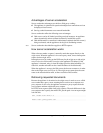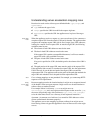
128 Intel NetStructure Cache Appliance Administrator’s Guide
Server acceleration
In Web proxy caching, the Intel NetStructure Cache Appliance handles arbitrary
Web requests to distant Web servers on behalf of a set of users. Server
acceleration (also known as reverse proxy caching or virtual Web hosting) is
slightly different. In server acceleration, the appliance is the Web server to which
the user is trying to connect. The Web server host name resolves to the appliance,
which is acting as the real Web server.
Having a fast, scalable, fault-tolerant appliance absorb the main Web server
request traffic can improve the speed and quality of service of Web serving,
reducing load and hot spots on the backup Web servers, while still maintaining
the publishing environment available on the backup Web servers.
If the appliance has the desired object in cache, it serves the document quickly. If
the document is not in cache, the appliance requests the document from another
backup Web server that has all the content. A configuration table specifies which
backup Web server has the required content.
A Web host can maintain a scalable appliance serving engine and maintain a set
of low-cost, low-performance, less reliable PC Web servers as the backup
servers. A single appliance can act as the virtual Web server for multiple backup
Web servers, as shown in Figure 6.
Figure 6 Intel NetStructure Cache Appliances as server accelerator (reverse proxy) for
a pair of Web servers
server
web
server
web
real.janes_books.com
The Intel NetStructure
Cache Appliance serves
documents on behalf of
real.janes_books.com
and
big.server.net
requests for
www.janes_books.com
and jazz.flute.org
resolve to virtual IP of
Intel NetStructure
Cache Appliance
world wide web
big.server.net
hosts jazz.flute.org
Intel
NetStructure
Cache
Appliance


















